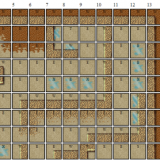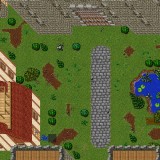BioShock: Graphic Violence in Video Games
Since when have playing games become all about how much blood sprays your screen when you bash someone over the head with a tire iron? Just this weekend I was over at my Cousin’s house and we were swapping video game favorites. His gift to me was Fable II (which I’m very interested in playing if it weren’t on XBOX) and BioShock. In fact, he put BioShock in and let me have at it.
Now I won’t disregard some of the really interesting concepts presented in this game. Everything from the underwater atmosphere, graphic detail and cool new powers that give you a pretty flexible play style. But I can honestly say I was a bit put off by the blood and guts violence. Do video games really need to be so graphically violent? You arrive at an underwater city and before you can even control your character’s actions you watch a maniac guy spill someone’s intestines. This is shortly followed by finding a nice heavy wrench and beating crazy people over the head until their brains are all over the floor.
Would this game be nearly as scary with the creepy upbeat music and crazy inhabitants? No, of course not. Would this game loose all playability if it weren’t nearly as bloody? My answer — no. There are perfectly good ways to make a scary video game, even a suspenseful video game without all the blood and guts. Take three examples:
Silent Hill. This is probably one of the scariest games I’ve ever played, and most of it was the atmosphere. Running around a deserted, foggy town with only the sound of your footsteps and distant cawing of crows. Sure, there was a disembodied corpse here or there and ugly monsters, but the blood is nearly non-existent during fight scenes.
Resident Evil. This game has a huge following. I think RE’s biggest selling point is that killing things isn’t the biggest aspect of game play. The monsters have enough arms and legs and tentacles to make you shiver but the blood and guts factor is pretty much non-existent. Most of the time you’re walking around deserted houses or streets, not looking at disemboweled corpses with knives sticking out of them like you do in BioShock.
Eternal Darkness. This game is a scary is a psychological way. Half the time you’re not sure if you’re really being killed or if the main character is having a hallucination. Eternal darkness plays with the psyche in a way I’ve never seen any other game do. It’ll give you goosebumps every time — without the blood.
Does the increasing violence in our video games mirror the changing attitude of the public? Of course all game companies are out to “give the consumer what they want.” Does that mean we’re all secretly aching to run around taking a chain-saw to people? I’m certainly not the only one who feels this way.
Legendary Nintendo designer Shigeru Miyamoto expressed his dissatisfaction with the industry’s growing predisposition toward violent software. Emphasizing the social responsibilities of game developers, Miyamoto told British television station Channel 4 (via Develop), “I don’t want to curb freedom of expression, but I am concerned many developers focus on excessive violence in order to stimulate people’s minds,” adding, “I believe that there are more ways of grabbing players’ attention than violence alone.” (source: http://www.1up.com/do/newsStory?cId=3170809)
Now I’m not saying there shouldn’t be violence in video games. Violence is a part of life we live with day to day, year after year. In fact according to the ESA, BioShock was the #19 best selling video game of 2007 in sales per units. #1 and #2 positions are dominated by World of Warcraft and it’s expansion pack, followed by Call of Duty4 in fourth place, and Command and Conquer in seventh. In all, twelve of the top twenty best selling games in 2007 had some kind of simulated violence. These games are selling well right now. But aren’t our video games supposed to be for entertainment? Isn’t that why we really play, to have fun? Does that mean every time we hear about a murder on TV we should jump up and think, +10 head shot I wonder how much blood got on the wall? Games are becoming more and more of an art form and in that case I would compare BioShock to skinning the family dog and hanging the corpse on the wall–crude, but well loved.
If we’re going to incorporate violence into video games I think we need to set some basic ground rules. The hyper realism really isn’t doing games any justice as far as violence goes. I’d rather see more realistic characters, shadows, shaders, and clothing then blood pools that ripple when I walk on by. Maybe that’s just me….














That’s funny. Normally, I love seeing blood, gore, and mangled body parts in video games, but I have yet to check out Bioshock to see if I would be turned off by it, too. RE4 had a bit of blood in it as you blew the heads off of the villagers, but I guess the coloring of it blended well with the other colors and atmosphere so it wasn’t *too* graphic.
Enjoyed your post. Thanks!
There are always a lot of pressure groups that blame all the problems in society on content like this. They will probably say this gory content will turn some people into killing “little angels”, There is no strong scientific link between games and realworld violence. You only have to look at the low crime statistics in Japan to figure that one out. For more info you can read on my blog. I would really appreciate it if you would share your point of view on my opinion article!
go to http://gameviolence.wordpress.com/
Old post I know, but it is a rather simplistic notion to presume that the only causal effect of constant exposure to graphic simulated violence is that such violence will potentially be re-enacted in real life. There are many other interesting psychological questions. For example, are there effects on a player’s potential for emotional expression? Their ability to empathise with the pain of others? Are their reactions (after long-term exposure to simulated violence) to episodes of real world violence altered? (Science probably cannot evaluate this ethically). I think these games also raise questions about the kind of culture that enjoys/desires extreme simulated violence, and in the reverse direction, what kind of culture these things contribute to the creation of.
I never said playing violent video games means people are going to re-enact it in real life. A mom who says or imagines she wants to kill her kids because they drive her crazy doesn’t mean she’s going to literally, kill her kids. I’m merely pointing out that removing some of the explicit violence/gore from a good game, in my opinion, doesn’t make it any less of a good game.
Take Zelda for instance. Would I play if I couldn’t run around with my sword slashing? Sure! There are plenty of other aspects of Zelda that I like outside of copping up bats and spiders and item bosses. Would more people play Zelda if the bats exploded and rained down in a shower of blood? Maybe, and maybe not. Personally, I’m not as inclined to fight/attack in games with heavy blood/violence if I can avoid it. Maybe it’s a gender or age difference, or maybe it’s even in how I was raised. The point is a good game is a good game even without the bloody hand prints on the wall.
Sorry, I was replying to the post above mine from “jonaderks”. I actually agree with you that gratuitous violence is just that.